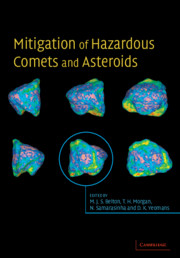Book contents
- Frontmatter
- Contents
- List of contributors
- Preface
- Acknowledgments
- Glossary
- 1 Recent progress in interpreting the nature of the near-Earth object population
- 2 Earth impactors: orbital characteristics and warning times
- 3 The role of radar in predicting and preventing asteroid and comet collisions with Earth
- 4 Interior structures for asteroids and cometary nuclei
- 5 What we know and don't know about surfaces of potentially hazardous small bodies
- 6 About deflecting asteroids and comets
- 7 Scientific requirements for understanding the near-Earth asteroid population
- 8 Physical properties of comets and asteroids inferred from fireball observations
- 9 Mitigation technologies and their requirements
- 10 Peering inside near-Earth objects with radio tomography
- 11 Seismological investigation of asteroid and comet interiors
- 12 Lander and penetrator science for near-Earth object mitigation studies
- 13 Optimal interception and deflection of Earth-approaching asteroids using low-thrust electric propulsion
- 14 Close proximity operations at small bodies: orbiting, hovering, and hopping
- 15 Mission operations in low-gravity regolith and dust
- 16 Impacts and the public: communicating the nature of the impact hazard
- 17 Towards a national program to remove the threat of hazardous NEOs
- Index
10 - Peering inside near-Earth objects with radio tomography
Published online by Cambridge University Press: 12 October 2009
- Frontmatter
- Contents
- List of contributors
- Preface
- Acknowledgments
- Glossary
- 1 Recent progress in interpreting the nature of the near-Earth object population
- 2 Earth impactors: orbital characteristics and warning times
- 3 The role of radar in predicting and preventing asteroid and comet collisions with Earth
- 4 Interior structures for asteroids and cometary nuclei
- 5 What we know and don't know about surfaces of potentially hazardous small bodies
- 6 About deflecting asteroids and comets
- 7 Scientific requirements for understanding the near-Earth asteroid population
- 8 Physical properties of comets and asteroids inferred from fireball observations
- 9 Mitigation technologies and their requirements
- 10 Peering inside near-Earth objects with radio tomography
- 11 Seismological investigation of asteroid and comet interiors
- 12 Lander and penetrator science for near-Earth object mitigation studies
- 13 Optimal interception and deflection of Earth-approaching asteroids using low-thrust electric propulsion
- 14 Close proximity operations at small bodies: orbiting, hovering, and hopping
- 15 Mission operations in low-gravity regolith and dust
- 16 Impacts and the public: communicating the nature of the impact hazard
- 17 Towards a national program to remove the threat of hazardous NEOs
- Index
Summary
Why radio tomography?
So far, the planetary explorations have focused on gathering information about the atmosphere, the ionosphere, and the surface of the planets. Most of the remote-sensing techniques have focused on observation of planets and small objects in visible and near-visible range using cameras, or GHz-range radars for surface mapping of planets (e.g., Magellan radar for Venus, Shuttle Imaging Radar (SIR A, B, and C), Shuttle Radar Topography Mapping SRTM and TOPEX/Poseidon for Earth). The radio science techniques used to study the gravity field are important for exploring planetary interior. Although these techniques have provided a wealth of information, there are still a large number of questions that cannot be answered unless we probe the sub-surface. Example of questions that radio tomography can answer are: (1) sub-surface stratigraphy on planets, (2) the existence of paleo-channels, (3) the depth of CO2 and H2O ice layers on Mars, (4) the existence of liquid water under the surface of Mars, (5) the existence of an ocean on Europa, and (6) looking inside comets, and testing the rubble-pile hypothesis for asteroids. It is well known that low-frequency electromagnetic waves (specifically, high-frequency (HF) and very-high-frequency (VHF) regimes) can penetrate ice and rocks to a depth of hundreds of meters to a few kilometers. Such radars have been used on Earth for sub-surface investigations. Also, airborne radar sounders have been deployed over the past few decades to investigate glaciers and to measure ice-layer thickness (Gudmandsen et al. 1975).
- Type
- Chapter
- Information
- Mitigation of Hazardous Comets and Asteroids , pp. 201 - 233Publisher: Cambridge University PressPrint publication year: 2004
- 3
- Cited by

